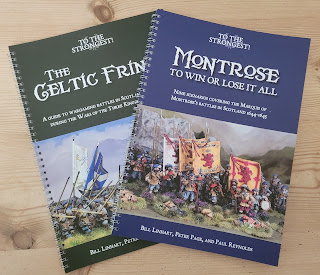Storage
We all know where a general keeps his armies*, but where do you keep yours?
My 6mm Heroics and Ros ECW armies lived in a Cadbury's chocolate fingers tin. Handy, but useless. Probably explains why the pikes looked like over cooked spaghetti.
As my 15mm Napoleonics armies grew to silly numbers, storage became an issue. At the time Sally 4th came up with their Warchests boxes and lids.
Warchests are laser cut MDF boxes which come in kit form. You'll need PVA glue and some elastic bands to assemble them. Easy to assemble, but for some reason I find the 52mm boxes the most tricky, often falling apart during that awkward act of putting the elastic bands on (to hold them together whilst the glue sets).
They now come in a number of variations (clear panel, pre-coloured, different sizes, magnetic bases etc). Mine are the basic ones: I use 35mm height boxes for casualty markers and foot figures; 52mm for cavalry, dragoons and artillery; and 70mm for foot regiments that have pikes.
A smart and simple solution to figure storage. Recommended.
Notes on building them.
My 6mm Heroics and Ros ECW armies lived in a Cadbury's chocolate fingers tin. Handy, but useless. Probably explains why the pikes looked like over cooked spaghetti.
As my 15mm Napoleonics armies grew to silly numbers, storage became an issue. At the time Sally 4th came up with their Warchests boxes and lids.
Warchests are laser cut MDF boxes which come in kit form. You'll need PVA glue and some elastic bands to assemble them. Easy to assemble, but for some reason I find the 52mm boxes the most tricky, often falling apart during that awkward act of putting the elastic bands on (to hold them together whilst the glue sets).
They now come in a number of variations (clear panel, pre-coloured, different sizes, magnetic bases etc). Mine are the basic ones: I use 35mm height boxes for casualty markers and foot figures; 52mm for cavalry, dragoons and artillery; and 70mm for foot regiments that have pikes.
 |
| The original version had no logo on the side; then v2 had a slightly smaller logo, this is the logo on v3 |
A smart and simple solution to figure storage. Recommended.
 |
| Regular readers will be pleased to read that all the empty space in this box has been filled |
 |
| They seem to be taking over, this is just about a quarter of the boxes containing my Civil War armies |
As I seem to have got rather a lot of them (86 at last count if you include the Napoleonics boxes), finding the right box was getting a bit tricky. So I have colour coded the boxes - blue dots are Covenanters, orange - Parliament, red - Royalists, green - Army of Montrose, purple - Irish Confederates, white - villagers and clubmen. Each box is also labelled, a clear Avery label. I used my usual chapbook italic font, allowed the ink to dry for 24 hours before a quick spray of Army Painter anti-shine varnish.
 |
| Should the Covenanters be next to Frith's Regimental History of Cromwell's Army? |
Notes on building them.
I find the easiest way of building the boxes themselves is to cut open the large plastic bag they come in, and use it to protect the cutting board. I start with the long side pieces and apply glue to the end tabs only. I then utilise a mug to balance the pieces on, whilst I apply glue to all sides of the base. then fit one long side, the two short sides are added, then the last long side piece. End braces are glued up seperately then fixed in place. Now is the time to utilise elastic bands to hold everything tight, whilst the glue sets. Don't be tempted to use masking tape - it peels part of the MDF surface away when you remove it.
Lids used to be easy, but have become more difficult. Note to self: the side pieces don't fit the tabs on the lid. Dry fit first - if they don't fit easily, trim the tabs on the side pieces. When everything fits 'dry, glue the edges of the lid board itself, then positioning one of the long sides on your work surface, push the lid into the side piece. Next up the glue the end tabs of the short side pieces and push them into place. Finally fit the last long side piece. Lids don't normally need an elastic band to hold everything in place whilst the glue sets.
*if you really are wondering, he keeps them up his sleevies. But you could have asked any five year old for the punchline...
If you enjoyed reading this, or any of the other posts, please consider supporting the blog.
Thanks.











Comments
Post a Comment